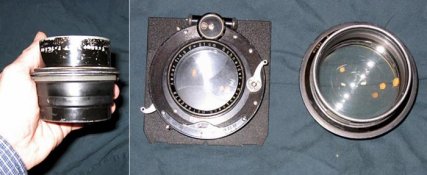Here's your lens, straight from the LVM:
Tessar f2.7 It was made in 15-165mm in 11 foci in 1926. It was noted as 2in =5cm for 1x0.75in movie; 3in or better 3.125in = 8cm for VP; 4in or 4.75in for 6x9cm; 5.75in for 1/4plate; 6.0in or 6.5in for 5x4in, 7in =18cm for 5.5x3.25in and 8.25in = 21cm for 6.5x4.75in.This Tessar was for cine+press use. They were later made in 0.375in (9mm) to 8.5in in 15 sizes in 1929). The coverage in B.J.A. 1926, p658 seems the same for the Tessar f2.7 as for the Triotar f3.5 and f3.0 and they are all tabled up together. Where they are all available in the same focus as in 4in, the Tessar is substantially more expensive: Tessar f2.7, £11.25; Tessar f3.5,£8.00; Tessar f4.5, £6.25;Triotar f3/f3.5, £5.50. This was a new lens, from designer Merte, in 1925 and were noted as a new series in B.J.A. 1926, p324). (But note it seems to be shown in a list thought to be from 1915, but possibly this was wrongly dated). The smallest 6 sizes were made for movie or cine. (Eg B.J.A. 1927, p329 with a TeleTessar above.) The 8cmwas for VP, while the longer were for large formats up to 6.25in (158.75mm) for 9x12cm (1/4plate)- thus using it on 5x4in is being rather unfairly demanding. The note suggests the optical performance equals the f4.5 Tessar but that real care is needed to acheive this due to the need for accurate focusing and emulsion flatness. It was seen as a 165mm at No 700,95x engraved BX2 (a plain iris mount) and 981,13x (engraved AX2) in a sunk focusing iris mount (these differed in flange, cell threads and most dimensions but the glass curves were the same), and an earlier version was f2.7/8cm No 764,98x on a Baby Deckrullo. (Such a camera was noted
in B.J.A. 1926, p356, p663advert.) A larger version was on the Miroflex in B.J.A. 1927, p302.
The f2.7 Tessar was noted at No666,43x as a 165mm on a Deckrullo, at No641,70x on a VP Baby Deckrullo and at No765,89x as a 165mm on a Tropical Nettel Klapp and later on a Miroflex (no number) and f2.7/165mm No785,40x on Miroflex M26,02x. A f2.7/5cm No645,45x was a movie lens on a wooden 35mm movie. Commercially, the f2.7 was important from the number in the Ariel list, in 20 and 50mm, from the 1920's. It was noted in the UK as f2.7/4cm No778,03x (c.1927), on a Kinamo and on a 16mm Movikon at about 2 million. Incidentally the 16mm Kinamo has also been seen with a f4.5/4cm Tessar at No474,27x. An early 8mm Kinamo had an f2.7/1.5cm Tessar at No867,88x. Fig 003 003 Zeiss Tessar f2.7/165mm as (l) barrel and (r) sfim mounts. Frerk lists it as about the 4th really fast lens issued in Germany, after the Ruo f2, the Ernostar f2 and Heliostigmat f2.5, and shows one on a Mentor 6.5x9cm Press camera. It shows really fine central image detail. Which is a way of saying that the image quality away from the centre is less good. This was understandable at the time, and it was a really desireable news gathering item on a wet afternoon in the 1920's, when it competed with the Pentac and Speedic on large reflexes and press cameras. Today, it seems to lack a crisp focus point but the centre records fine detail. But outside 6x9cm it is well soft. It is heavy and very bulky and hard to mount to cameras such as MPP MicroTechnicals and even Linhofs, which have a much bigger aperture in the front standard.The central image was good enough to allow it to continue as a cine lens into the 1930's, but the design seemingly was revised for the Movikon 16mm as it seems there is a Patent for a reversed Tessar f2.7 for 45°at that period.(USPat 1,826,362). This used glasses G1+4=1.62177/56.8; G2= 1.52547/52.8; G3=1.62559. The 1920's lens had a normal Tessar layout from examining an example, not the reversed version shown in one period account, where the late type was probably seen. There is also a version
in Brit Pat 256,586/1925. (Layout Zei034).
So that wasn't much of a challenge at all! Go and enjoy yourself with this lens. Whenever you find much the same lens but as a 2.8 and the Bio-Tessar name on it for $20, give us a holler and we'll be right over.

Will you show us how it performs?
HTH, Norm









 Will you show us how it performs?
Will you show us how it performs?



